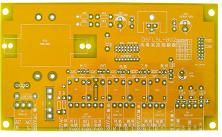Solder mask is an important part of today's printed circuit board technology. The use of PCB solder mask has become so common, it is most unusual to see that printed circuit boards without any solder resist coverage, except for some home-built circuits today, and even many prototype boards have solder masks, so their use is commercialized. Printed circuit boards can be said to be universal.
The purpose of printed circuit board soldering
As its name suggests, solder mask covers the area of the printed circuit board used to protect the printed circuit board from taking solder on the circuit board. In this way only a solder-covered area is actually required, that is, where the component is the area to be soldered, solder resist is free, and soldering can be performed, which offers many advantages. The most important thing is that it only needs to have solder whereit has, and reach some areas by the solder to prevent corrosion of small short circuits caused by solder bridges can be significantly reduced. This is more and more important, because the very fine pitch of many printed circuit boards today means that small solder tracks in the soldering process can easily cause bridges and short circuits. Use solder mask to limit the areas where components will be soldered where this problem is, and these areas can be designed accordingly.

In addition to its function in preventing the solder from causing small bridges, the solder of the printed circuit board also acts as a protective layer for the substrate. Solder mask provides electrical insulation and protection against oxidation and corrosion. This over a period of time can improve the overall reliability of the printed circuit board, especially if it is exposed to harmful reagents.
The role of PCB solder mask and flux
What is PCB flux?
The solder resist of the printed circuit board is a permanent resin-based coating applied to the printed circuit board during the manufacturing process of the bare board. Solder mask is a permanent coating of resin formulations, usually green in color, which encapsulates and protects all surface features of printed circuit boards, unless it is necessary to form specific areas of solder joints.
Although green is the most widely used color for solder resist, almost any color can be used. Although it can be difficult to maintain accurate colors, it is possible to make them almost any color. However, from green, other popular colors are red and blue.
Apply PCB solder mask
In order to make the solder mask of the printed circuit board meet the very precise requirements of today's surface mounting technology, SMT printed circuit board, liquid photosensitive (LPI) solder resist is used. Previously printed circuit board soldering used stencil printing used in silk screen resisting applications.
The LPI process for solder mask is very different from the previously used stencil printing. LPI separates coating and imaging operations to obtain the highest level of precision. The material used in the PCB solder mask by the bare printed circuit board manufacturer is in the form of a liquid photopolymer, and it uses epoxy or epoxy-acrylate resin technology and the entire board is coated with the material. The thickness of the material is usually about 30 microns to 20 microns or more copper on the bare board. Once the flux-coated resist material is dried, it is exposed to the desired image pattern and then unfolded to obtain the desired solder resist pattern. Then developed a solder mask post-curing to ensure that it provides a tough and long-lasting finish for heat dissipation.